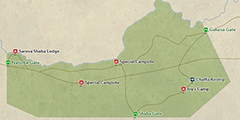Beautiful Shaba National Reserve is a real wilderness experience. This scenically stunning reserve shares the same ecosystem as the better-known Samburu and Buffalo Springs National Reserves, although you’re far less likely to see wildlife here in Shaba. Most Shaba-based lodges conduct their in Buffalo Springs. Shaba is ideal for those looking to remain a step removed from busy safari circuits.

-
Best Time To Go
- June to September and January to February
-
High Season
- December to March and July to October (Busy)
-
Size
- 239km² / 92mi²
-
Altitude
-
731-1,313m /2,398-4,308ft
 View Photos
View Photos
 View Photos
+19
Photos
View Photos
+19
Photos
 Open Map
Open Map
Pros & Cons
- Little-visited reserve with great wilderness appeal
- Easy access to Buffalo Springs for great wildlife viewing
- Beautiful and arid scenery
- Excellent birding with many dry-country specials
- Only two lodges
- Very hot and dry
Wildlife
Shaba is not a great wildlife destination. Although it’s connected to the excellent Samburu and Buffalo Springs National Reserves, animal densities are low here. Four of the Big Five can be encountered (no rhino), but they are hard work to see. Shaba has some of Kenya’s dry-country specials, including Beisa oryx, lesser kudu, reticulated giraffe, Grevy's zebra and gerenuk. The Ewaso Nyiro River is a good place to look for Nile crocodiles.
More about Shaba's wildlifeScenery
Much of Shaba’s charm lies in the splendor of its topography, which includes deep gorges and waterfalls on the scenic Ewaso Nyiro River. Open grasslands dotted with springs and swamps give way to rocky hills and dusty plains strewn with lava boulders. Massive Shaba Hill towers over this appealing landscape.
Activities
Wildlife and bird watching on guided game drives is the only real activity in Shaba. Most game drives combine time in Shaba with longer periods in the neighboring, more wildlife-rich Buffalo Springs and Samburu. Remember, however, that only Buffalo Springs can be visited on the same ticket. Going to Samburu will cost extra in reserve fees.
Weather & Climate
You’ll appreciate the sunshine during the Dry season (June to September). But the heat does tend to build to uncomfortable levels at the close of the period when the rains are due. The Wet season (October to May) is really three seasons in one: starting with the short rains, followed by a brief dry spell, then the long rains (mostly showers) that usually begin in March.
More about the weather and climateBest Time To Visit
The Dry season (June to September) and the short dry patch during January and February that interrupts the Wet season (October to May) are good times to check out the local animals. Another plus is that the absence of water means a greatly reduced risk of malaria. You can still visit the park in the wetter months, but heavy rain can potentially disrupt your safari plans.
More about the best time to visit



